Ensemble Learning-Based Soft Computing Approach for Future Precipitation Analysis
Abstract
1. Introduction
2. Materials and Methods
2.1. Nonlinear Principal Component Analysis (NLPCA)
2.2. Adaptive Neuro-Fuzzy Inference System (ANFIS)
- (1)
- Input layer
- (2)
- Rules Layer
- (3)
- Normalization Layer
- (4)
- Summation Layer
- (5)
- Output Layer
3. Data Introduction
3.1. GCM Model Data
3.2. Overview of Historical Rainfall Data
4. Model Development
4.1. Development Process of the ELADM Model
4.2. Selection of the Number of Nonlinear Principal Components
4.3. Performance Evaluation of the BADM Model
4.4. Evaluation of Historical Scenario Performance of the Optimal BADM Model
5. Results and Discussions
5.1. Monthly Precipitation Evaluation for Future Scenarios
5.2. Exceeding Probiblity of Precipitation for Future Scenarios
5.3. Evaluation of Uncertainitu of Precipitation Under Future Scenarios
6. Conclusions
- With the use of NLPCA for nonlinear data feature extraction, the number of original features in the three GCM models was reduced from between 12 and 23 to between 3 and 6 NLPCs through nonlinear dimensionality reduction, achieving a cumulative explained variance ratio of 93.5%. This demonstrates that NLPCA effectively reduces nonlinear dimensionality in the data.
- The GCM data used for constructing the BADM models for Tamsui and Taichung reveal that the MRMC exhibits significantly larger errors, a higher number of NLPCA components, and greater variability and uncertainty.
- Under the future RCP 4.5 scenario, rainfall trends are similar to historical rainfall characteristics, with relatively low uncertainty. However, under the RCP 8.5 scenario, significant differences are observed between future mid- and long-term rainfall trends and historical patterns during the wet season in both Tamsui and Kaohsiung. This indicates that the RCP 8.5 scenario could lead to greater variability in wet-season rainfall across northern and southern Taiwan, highlighting the need for proactive planning in water resource management.
- In both Tamsui and Kaohsiung, the future exceedance probabilities of monthly rainfall show higher probability in the dry season and lower probability in the wet season, regardless of the future time horizon (mid- or long-term) or scenario (RCP 4.5 or RCP 8.5). This suggests an elevated risk of increased rainfall during the dry season and a heightened risk of reduced rainfall during the wet season in the future.
- With the ELADM model, GCM mid-term and long-term rainfall variances were predicted, and the percentage increase or decrease relative to historical rainfall was calculated. The results indicate that regardless of emission scenarios (RCP 4.5 and RCP 8.5), the ELADM model shows higher rainfall variability in dry seasons compared to wet seasons in Kaohsiung, highlighting the need to improve prevention against potential climate change-induced disaster risks during dry seasons.
- The BADM models developed using the EL algorithm exhibit smaller RMSE, indicating higher model reliability. This approach can also be applied to future rainfall projections in other regions.
7. Limitations and Future Work
Author Contributions
Funding
Institutional Review Board Statement
Informed Consent Statement
Data Availability Statement
Acknowledgments
Conflicts of Interest
References
- Lin, L.Y.; Lin, C.T.; Chen, Y.M.; Cheng, C.T.; Li, H.C.; Chen, W.B. The Taiwan climate change projection information and adaptation knowledge platform: A decade of climate research. Water 2022, 14, 358. [Google Scholar] [CrossRef]
- Khadka, D.; Babel, M.S.; Abatan, A.A.; Collins, M. An evaluation of CMIP5 and CMIP6 climate models in simulating summer rainfall in the Southeast Asian monsoon domain. Int. J. Climatol. 2022, 42, 1181–1202. [Google Scholar] [CrossRef]
- Zhang, K.M.; Fan, G.Z. CMIP5 model for surface temperature simulation and estimation in Qinghai-Tibet plateau region. Plateau Mt. Meteorol. Res. 2021, 41, 80–89. Available online: http://www.gysdqxyj.cn/article/doi/10.3969/j.issn.1674-2184.2021.01.011 (accessed on 26 May 2025).
- Lin, S.S.; Hu, Y.L.; Zhu, K.Y. Downscaling model for rainfall based on the influence of typhoon under climate change. J. Water Clim. Change 2022, 13, 2443–2458. [Google Scholar] [CrossRef]
- Lin, S.S.; Yeh, W.L.; Zhu, K.Y.; Ho, Y.D.; Wu, W.C. Applying the Deep Neural Network to Estimate Future Trend and Uncertainty of Rainfall under Climate Change. Res. Sq. 2022. [Google Scholar] [CrossRef]
- Lin, S.S.; Zhu, K.Y.; Wang, C.Y. A Deep Learning-Based Downscaling Method Considering the Impact on Typhoons to Future Precipitation in Taiwan. Atmosphere 2024, 15, 371. [Google Scholar] [CrossRef]
- Lin, S.S.; Zhu, K.Y.; Huang, H.Y. Integration of deep learning neural networks and feature-extracted approach for estimating future regional precipitation. Atmosphere 2025, 16, 165. [Google Scholar] [CrossRef]
- Wu, H.J.; Ye, X.D.; Zhang, B.Y.; Chen, B. Assessment of uncertainty propagation from climate modeling to hydrologic forecasting under changing climatic conditions. J. Environ. Inform. 2025, 45, 27. [Google Scholar] [CrossRef]
- Zhou, Y.; Guo, S.; Chang, F.J. Explore an evolutionary recurrent ANFIS for modelling multi-step-ahead flood forecasts. J. Hydrol. 2019, 570, 343–355. [Google Scholar] [CrossRef]
- Zhou, Y.; Chang, F.J.; Guo, S.; Ba, H.; He, S. A robust recurrent anfis for modeling multi-step-ahead flood forecast of three gorges reservoir in the yangtze river. Hydrol. Earth Syst. Sci. Discuss. 2017, 2017, 1–29. [Google Scholar] [CrossRef]
- Bakare, M.S.; Abdulkarim, A.; Shuaibu, A.N.; Muhamad, M.M. Enhancing solar power efficiency with hybrid GEP ANFIS MPPT under dynamic weather conditions. Sci. Rep. 2025, 15, 5890. [Google Scholar] [CrossRef] [PubMed]
- Achouri, M.; Zennir, Y.; Tolba, C. Adaptive hybrid ANFIS-PSO and ANFIS-GA approach for occupational risk prediction. Int. J. Occup. Saf. Ergon. 2025, 1–15. [Google Scholar] [CrossRef]
- Li, C.; Li, Z.; Jun, X.; Pi, W. The impact of data quality on neural network models. In Cyber Security Intelligence and Analytics; Springer International Publishing: Berlin/Heidelberg, Germany, 2020; pp. 657–665. [Google Scholar] [CrossRef]
- Gharawi, A.A.; Alsubhi, J.; Ramaswamy, L. Impact of labeling noise on machine learning: A cost-aware empirical study. In Proceedings of the 2022 21st IEEE International Conference on Machine Learning and Applications (ICMLA), Nassau, Bahamas, 12–14 December 2022; pp. 936–939. [Google Scholar] [CrossRef]
- Soni, A.; Arora, C.; Kaushik, R.; Upadhyay, V. Evaluating the impact of data quality on machine learning model performance. J. Nonlinear Anal. Optim. 2023, 14, 0013–0018. [Google Scholar] [CrossRef]
- Jang, J.S. ANFIS: Adaptive-network-based fuzzy inference system. IEEE Trans. Syst. Man Cybern. 1993, 23, 665–685. [Google Scholar] [CrossRef]
- Hsieh, W.W. Nonlinear principal component analysis of noisy data. Neural Netw. 2007, 20, 434–443. [Google Scholar] [CrossRef] [PubMed][Green Version]
- Schapire, R.E. The strength of weak learnability. Mach. Learn. 1990, 5, 197–227. [Google Scholar] [CrossRef]
- Wolpert, D.H. Stacked generalization. Neural Netw. 1992, 5, 241–259. [Google Scholar] [CrossRef]
- Breiman, L. Bagging predictors. Mach. Learn. 1996, 24, 123–140. [Google Scholar] [CrossRef]
- Das, J.; Manikanta, V.; Nikhil Teja, K.; Umamahesh, N.V. Two decades of ensemble flood forecasting: A state-of-the-art on past developments, present applications and future opportunities. Hydrol. Sci. J. 2022, 67, 477–493. [Google Scholar] [CrossRef]
- Manikanta, V.; Teja, K.N.; Das, J.; Umamahesh, N.V. On the verification of ensemble precipitation forecasts over the Godavari River basin. J. Hydrol. 2023, 616, 128794. [Google Scholar] [CrossRef]
- Kramer, M.A. Nonlinear principal component analysis using autoassociative neural networks. AIChE J. 1991, 37, 233–243. [Google Scholar] [CrossRef]
- Hsieh, W.W. Nonlinear multivariate and time series analysis by neural network methods. Rev. Geophys. 2004, 42. [Google Scholar] [CrossRef]
- Hsieh, W.W. Nonlinear principal component analysis: A new information criterion for model selection in noisy climate datasets (Invited Speaker). In Proceedings of the Fifth Conference on Artificial Intelligence Applications to Environmental Science, Antonio, TX, USA, 14–18 January 2007; Available online: https://ams.confex.com/ams/87ANNUAL/webprogram/Paper116761.html (accessed on 26 May 2025).
- Sugeno, M. An introductory survey of fuzzy control. Inf. Sci. 1985, 36, 59–83. [Google Scholar] [CrossRef]
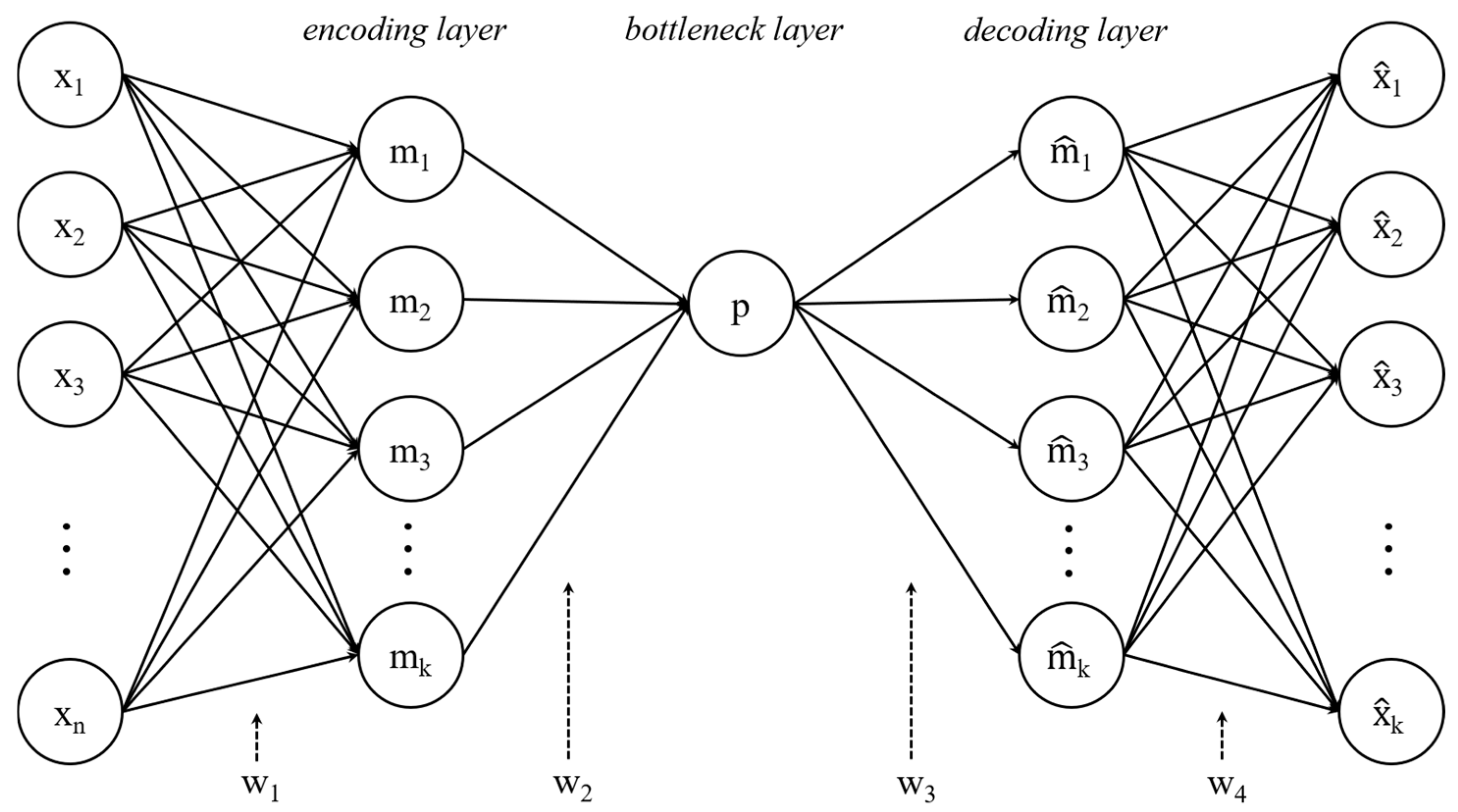
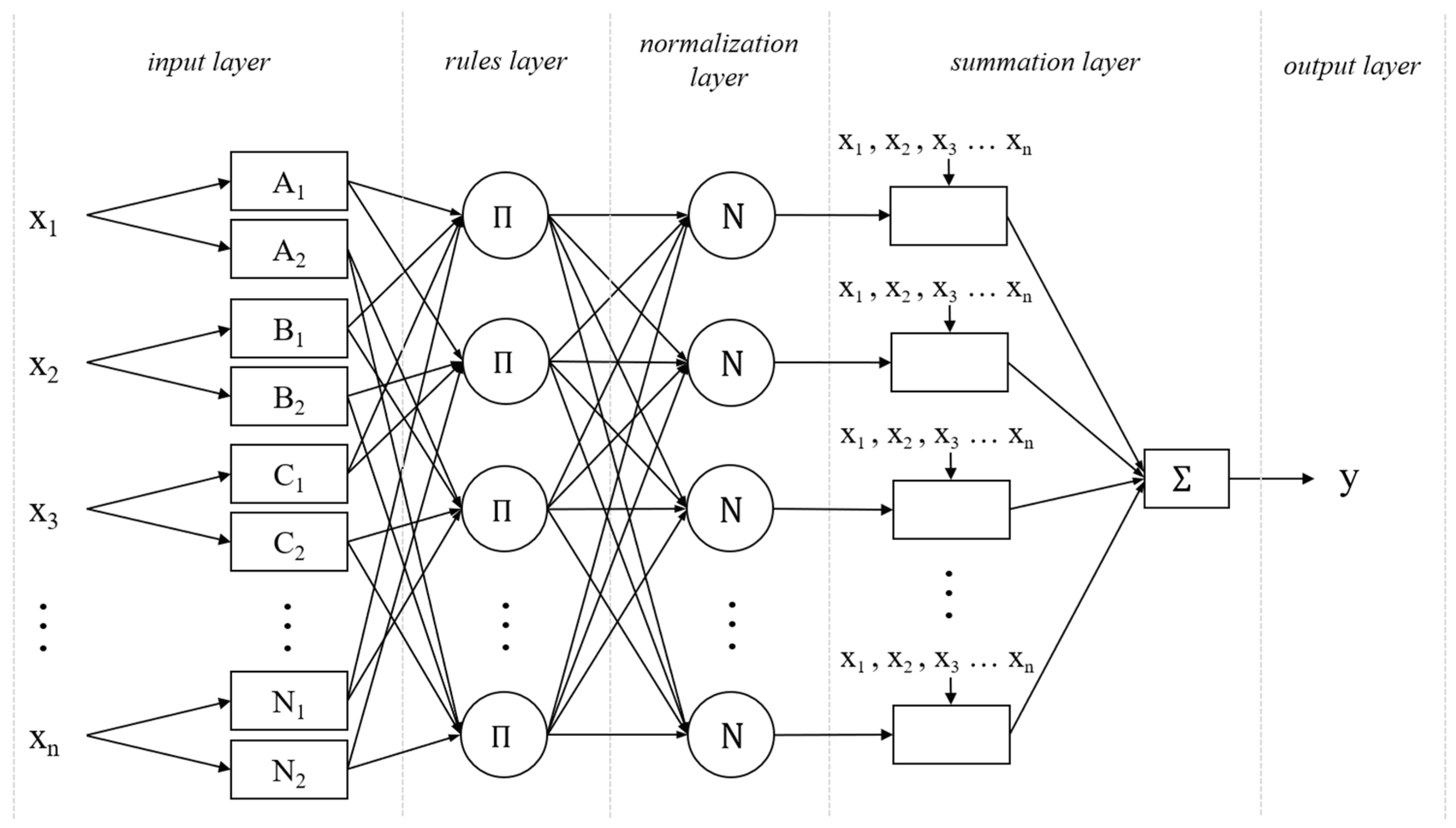
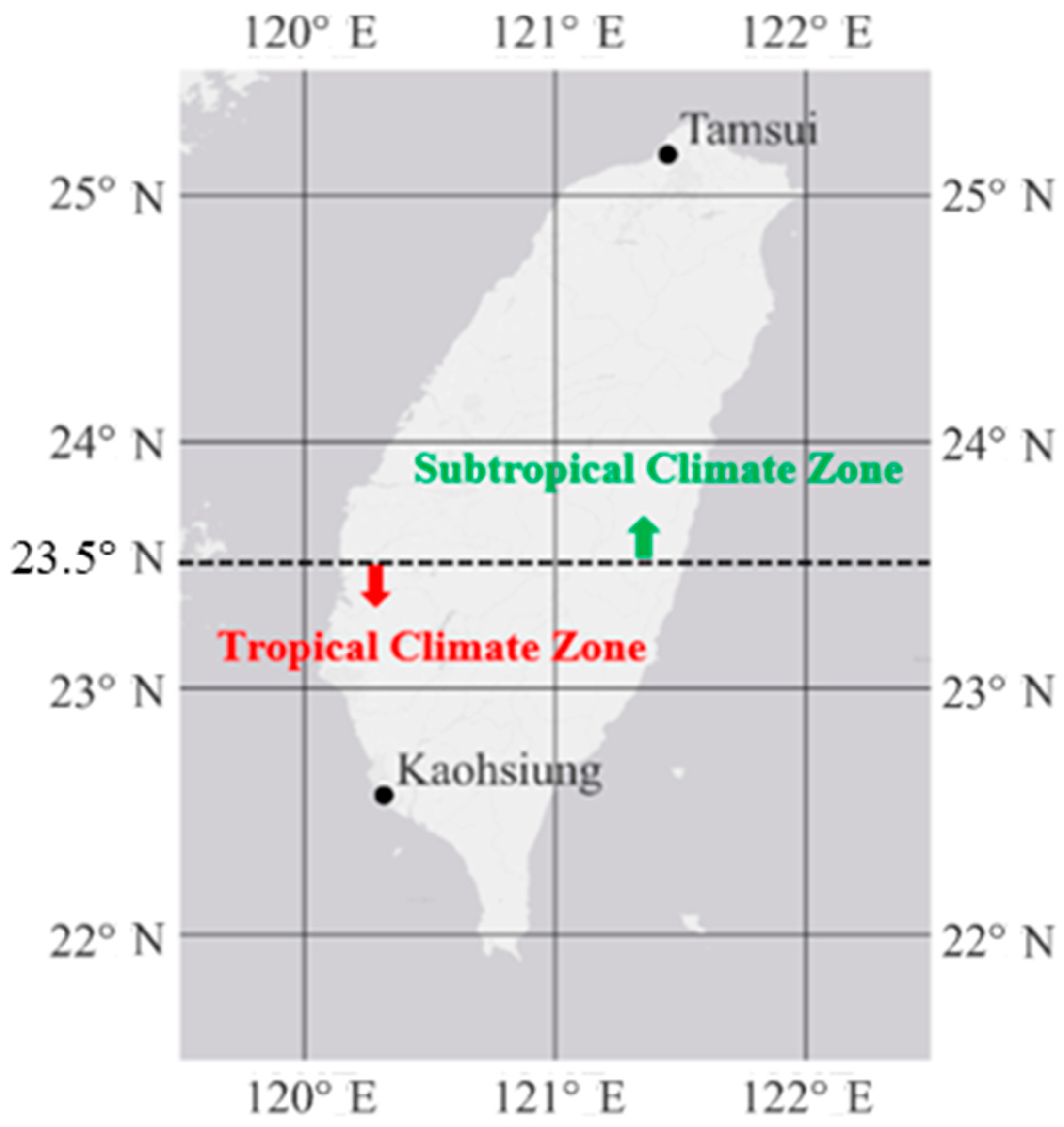

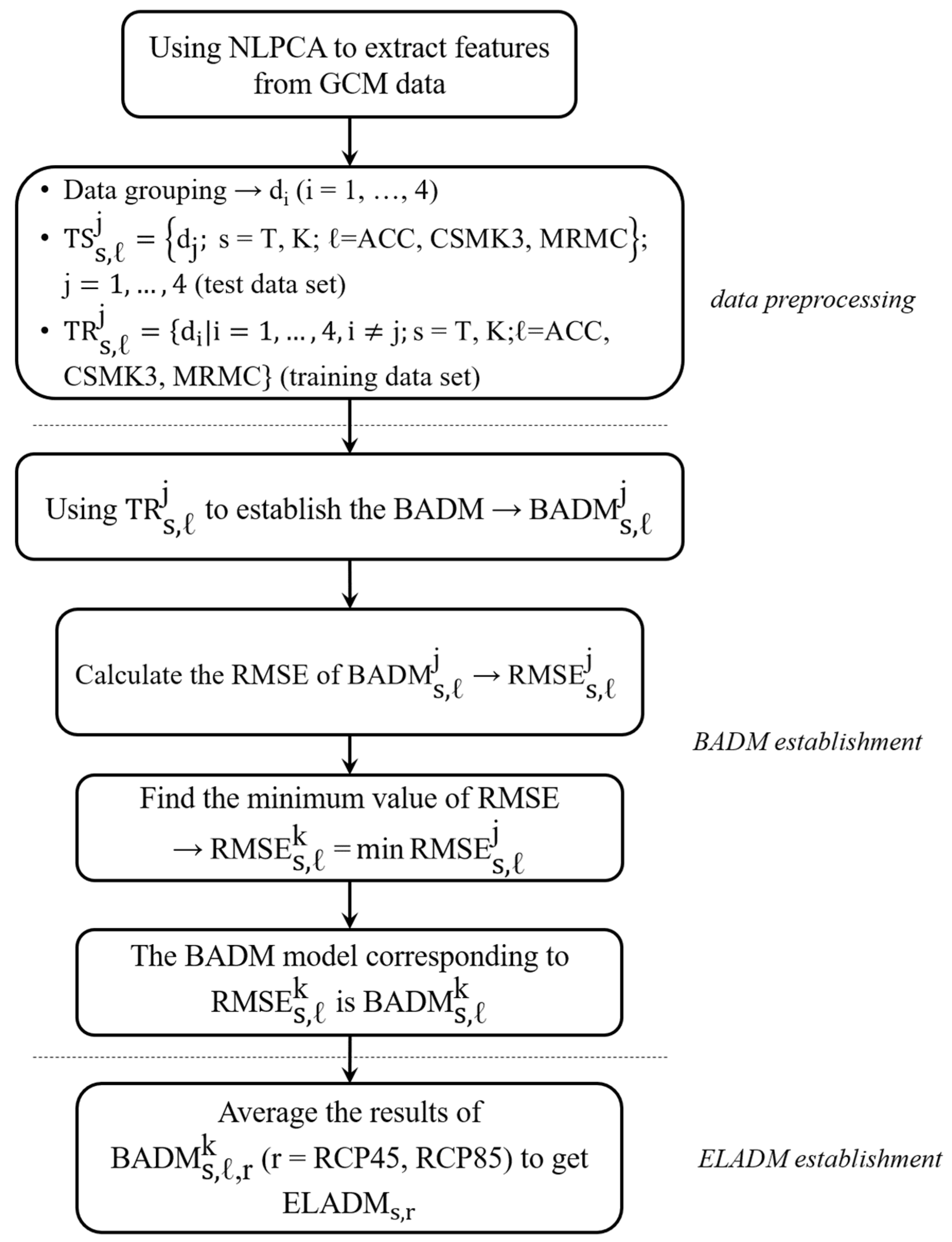



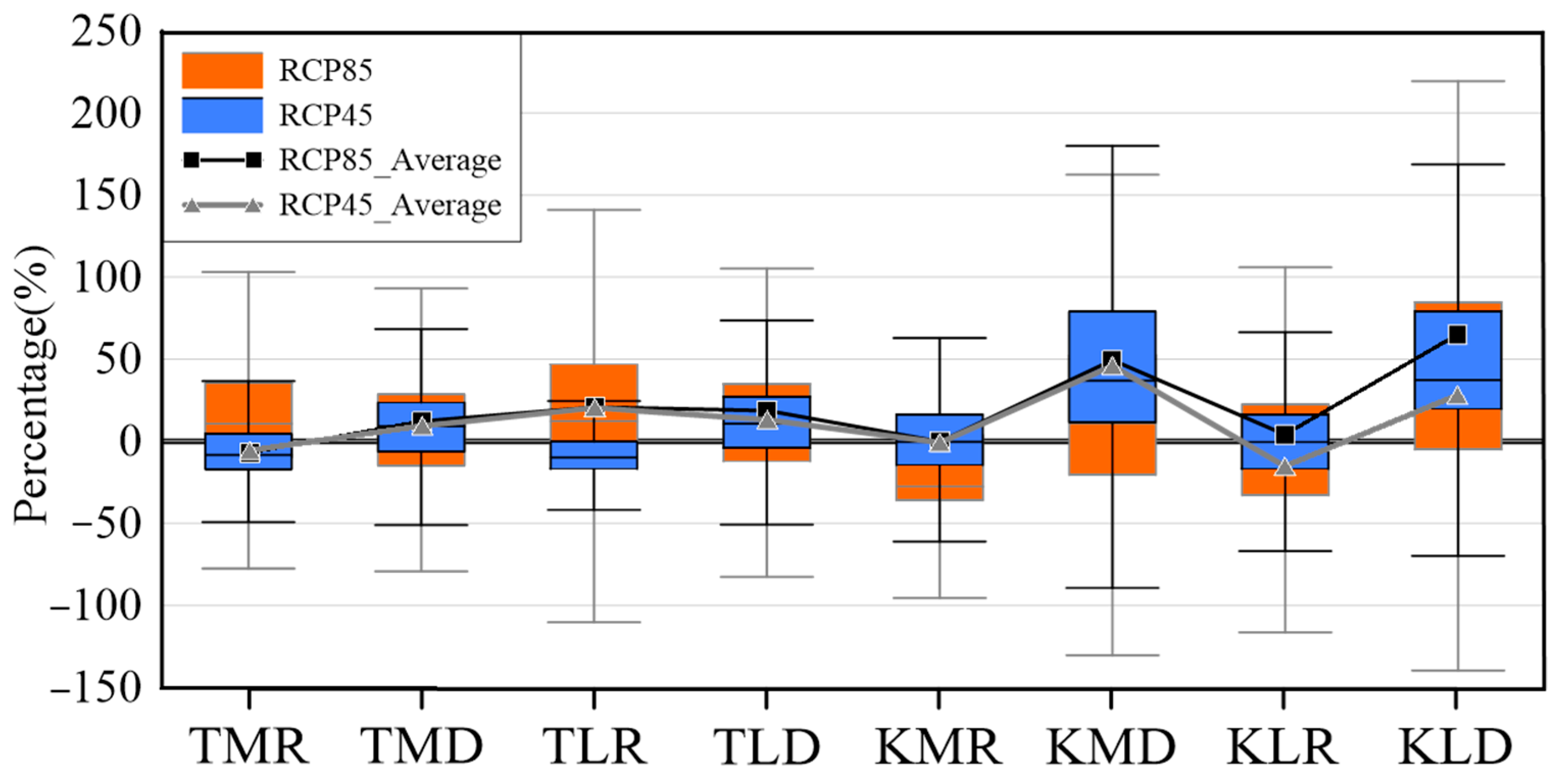
| Models | Abbreviation | Resolution | Number of Variables | Historical Data Length | Data Length of Mid-Term Scenario | Data Length of Long-Term Scenario |
|---|---|---|---|---|---|---|
| ACCESS1.0 | ACC | 192 (km) × 145 (km) | 19 | 1950/01–2005/12 | 2061/01–2080/12 | 2081/01–2100/12 |
| CSIRO-MK3.6.0 | CSMK3 | 192 (km) × 96 (km) | 12 | 1950/01–2005/12 | 2061/01–2080/12 | 2081/01–2100/12 |
| MRI-CGCM3 | MRMC | 320 (km) × 160 (km) | 23 | 1950/01–2005/12 | 2061/01–2080/12 | 2081/01–2100/12 |
| Station Name | Station Code | Coordinate | Data Period | Duration (Month) |
|---|---|---|---|---|
| Tamsui | 466900 | (121°26′24″ E, 25°09′56″ N) | 1950/01–2005/12 | 672 |
| Kaohsiung | 467440 | (120°18′29″ E, 22°34′04″ N) | 1950/01–2005/12 | 672 |
| Station Name | GCM | Group Number | Duration of TR | Duration of TS |
|---|---|---|---|---|
| Tamsui | ACC | 1 | 1950/01–1991/12 | 1992/01–2005/12 |
| 2 | 1950/01–1977/12, 1992/01–2005/12 | 1978/01–1991/12 | ||
| 3 | 1950/01–1963/12, 1978/01–2005/12 | 1964/01–1977/12 | ||
| 4 | 1964/01–2005/12 | 1950/01–1963/12 | ||
| CSMK3 | 1 | 1950/01–1991/12 | 1992/01–2005/12 | |
| 2 | 1950/01–1977/12, 1992/01–2005/12 | 1978/01–1991/12 | ||
| 3 | 1950/01–1963/12, 1978/01–2005/12 | 1964/01–1977/12 | ||
| 4 | 1964/01–2005/12 | 1950/01–1963/12 | ||
| MRMC | 1 | 1950/01–1991/12 | 1992/01–2005/12 | |
| 2 | 1950/01–1977/12, 1992/01–2005/12 | 1978/01–1991/12 | ||
| 3 | 1950/01–1963/12, 1978/01–2005/12 | 1964/01–1977/12 | ||
| 4 | 1964/01–2005/12 | 1950/01–1963/12 | ||
| Kaohsiung | ACC | 1 | 1950/01–1991/12 | 1992/01–2005/12 |
| 2 | 1950/01–1977/12, 1992/01–2005/12 | 1978/01–1991/12 | ||
| 3 | 1950/01–1963/12, 1978/01–2005/12 | 1964/01–1977/12 | ||
| 4 | 1964/01–2005/12 | 1950/01–1963/12 | ||
| CSMK3 | 1 | 1950/01–1991/12 | 1992/01–2005/12 | |
| 2 | 1950/01–1977/12, 1992/01–2005/12 | 1978/01–1991/12 | ||
| 3 | 1950/01–1963/12, 1978/01–2005/12 | 1964/01–1977/12 | ||
| 4 | 1964/01–2005/12 | 1950/01–1963/12 | ||
| MRMC | 1 | 1950/01–1991/12 | 1992/01–2005/12 | |
| 2 | 1950/01–1977/12, 1992/01–2005/12 | 1978/01–1991/12 | ||
| 3 | 1950/01–1963/12, 1978/01–2005/12 | 1964/01–1977/12 | ||
| 4 | 1964/01–2005/12 | 1950/01–1963/12 |
| Value Number | Penalty | m | HIC | Total Variance (%) | Cumulative (%) |
|---|---|---|---|---|---|
| NLPC 1 | 0.01 | 2 | 0.064 | 57.818 | 57.818 |
| NLPC 2 | 0.1 | 2 | 0.136 | 18.057 | 75.875 |
| NLPC 3 | 0.1 | 4 | 0.159 | 10.206 | 86.081 |
| NLPC 4 | 0.01 | 4 | 0.288 | 4.080 | 90.161 |
| NLPC 5 | 0 | 2 | 0.541 | 1.786 | 91.947 |
| NLPC 6 | 0 | 3 | 0.432 | 1.523 | 93.470 |
| Best BADM | MF | NLPC | RMSE (mm) |
|---|---|---|---|
| 2 | 4 | 111.58 | |
| 2 | 3 | 112.64 | |
| 2 | 6 | 127.18 | |
| 2 | 5 | 129.08 | |
| 2 | 4 | 122.93 | |
| 2 | 6 | 135.58 |
Disclaimer/Publisher’s Note: The statements, opinions and data contained in all publications are solely those of the individual author(s) and contributor(s) and not of MDPI and/or the editor(s). MDPI and/or the editor(s) disclaim responsibility for any injury to people or property resulting from any ideas, methods, instructions or products referred to in the content. |
© 2025 by the authors. Licensee MDPI, Basel, Switzerland. This article is an open access article distributed under the terms and conditions of the Creative Commons Attribution (CC BY) license (https://creativecommons.org/licenses/by/4.0/).
Share and Cite
Lin, S.-S.; Zhu, K.-Y.; Wang, C.-Y.; Yang, C.-P.; Liu, M.-Y. Ensemble Learning-Based Soft Computing Approach for Future Precipitation Analysis. Atmosphere 2025, 16, 669. https://doi.org/10.3390/atmos16060669
Lin S-S, Zhu K-Y, Wang C-Y, Yang C-P, Liu M-Y. Ensemble Learning-Based Soft Computing Approach for Future Precipitation Analysis. Atmosphere. 2025; 16(6):669. https://doi.org/10.3390/atmos16060669
Chicago/Turabian StyleLin, Shiu-Shin, Kai-Yang Zhu, Chen-Yu Wang, Chou-Ping Yang, and Ming-Yi Liu. 2025. "Ensemble Learning-Based Soft Computing Approach for Future Precipitation Analysis" Atmosphere 16, no. 6: 669. https://doi.org/10.3390/atmos16060669
APA StyleLin, S.-S., Zhu, K.-Y., Wang, C.-Y., Yang, C.-P., & Liu, M.-Y. (2025). Ensemble Learning-Based Soft Computing Approach for Future Precipitation Analysis. Atmosphere, 16(6), 669. https://doi.org/10.3390/atmos16060669








